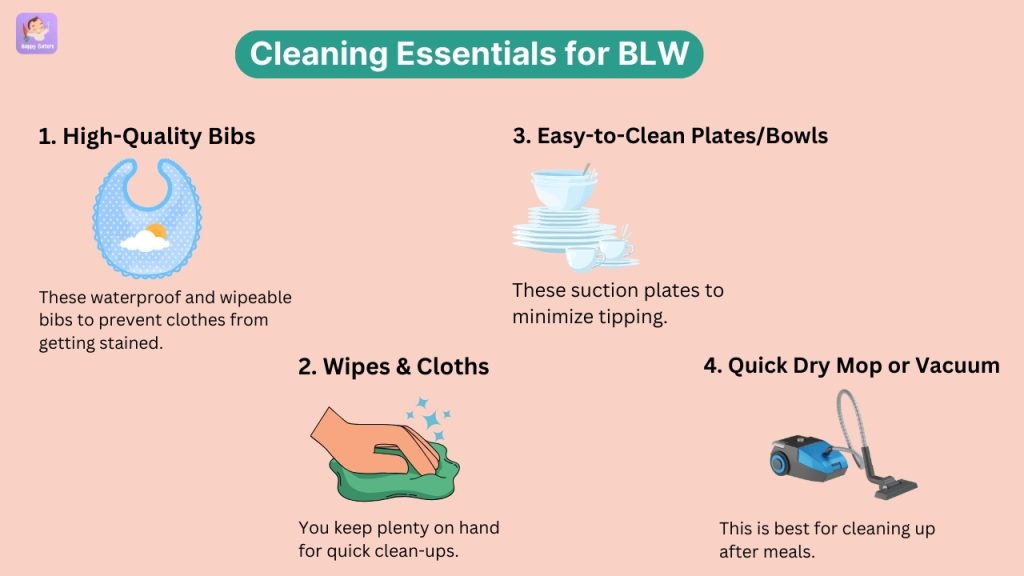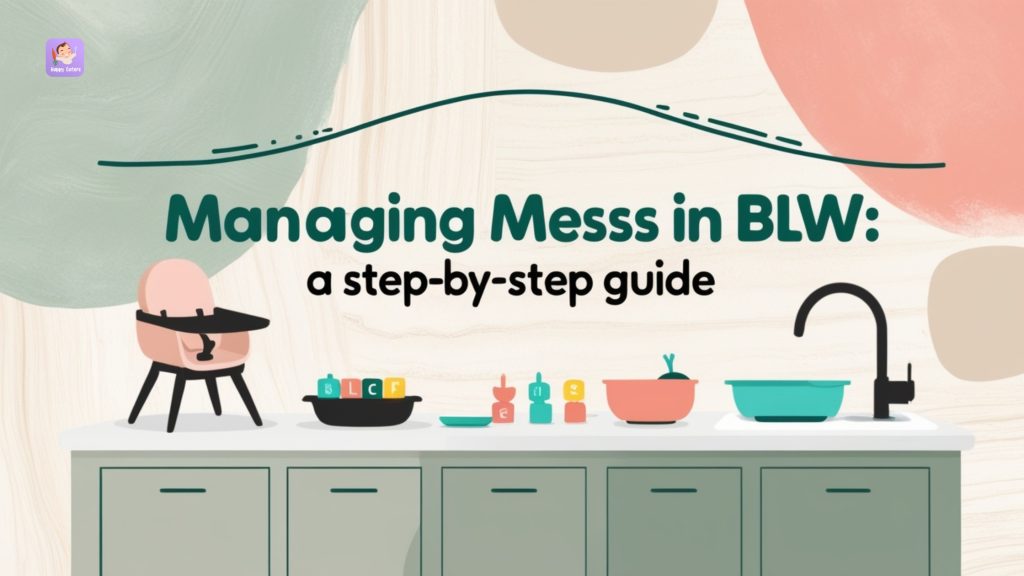Baby-led weaning says that you should let your baby pick up their food and feed themselves at their own pace. This way of eating helps them learn about different flavours, textures and tastes of weaning foods, right from the beginning.
With traditional weaning, babies are mostly spoon-fed purees which limits their knowledge of textures as well as their exposure to different kinds of foods. Infant led weaning has several benefits but it comes with its own set of limitations – namely mess and more mess!!
If you are giving the reins to your baby, then their food is bound to end up on the floor, all over themselves and even on the walls! But don’t worry—this mess means that your baby is learning something new, which is a crucial part of their entire life.
Many parents worry about the mess that accompanies BLW, but the pros far outweigh the cons. Mess can be cleaned, but tidying up wrong eating habits may take years or even decades. That is why we have the best baby weaning app to help you solve all your queries related to BLW, mess, and baby self feeding.
With BLW, babies learn to play with food and then eventually eat it, thereby forming a bond with food at a very young age. This, in turn, helps in building lifelong healthy eating habits. This guide is to help parents of BLW babies to make baby led weaning manageable, less messy and fun.
How Can You Manage Mess During Baby Led Weaning?
1. Set Up the Space for Easy Clean-Up
Starting your baby on infant led feeding doesn’t have to be a task. Think of your baby as a regular part of your family, as opposed to someone who needs a special place to sit and eat.
- Choose the best spot for your baby to enjoy their food.
- This could either be your family’s dining table or your regular dining area.
- If using a high chair, place it on your family’s dining table.
- You can also make your baby sit on the floor and eat. However, this may lead them to run here and there, so you would need to supervise them.
- The food tray should be big enough to hold most of the mess, and ideally, easy to wipe down after meals.
- Lay down a mat or something similar under the high chair to save your floor from getting messy.
- A big plastic mat or an old sheet can catch those food bits, making clean-up simpler and quicker. You can think about what works best for your kitchen or dining room.
- Baby wipes are super helpful for wiping tiny hands and faces after eating.
- A damp cotton or soft washcloth works wonders to clean up your baby! Having these items handy will make the process of BLW weaning easier.

2. Offer Small Portions at a Time
Starting with small portions and a single food makes mealtime easier for you and your baby. Try introducing just one new food at each meal to help your baby feel less overwhelmed by too many choices. This simple approach also lets them learn about each food on its own.
Keep portions small when you put food on your baby’s plate. Three or four pieces of finger food are plenty to start with—you can always offer second helpings if your baby is hungry. Soft-cooked veggies, mashed khichdi balls, omelette strips and roti strips are great options. You can also offer them mashed foods to eat with their hands or preload it and offer in baby-friendly spoons.
It’s best to avoid runny foods like purees, soups or buttermilk at first. When your baby gets used to handling food nicely on their own, then you may offer these foods. On the contrary, offer thick paste-like porridges, soups and purees that are easy for your baby to handle.
Baby led weaning is all about the baby feeding themselves. One loophole is to preload porridges, soups or purees on baby-friendly spoons and then offer it to your baby. Let the baby handle the spoon themselves and feed (or make a mess!)
3. Serve Food in Appropriate Sizes
Serving food in the right size makes mealtimes smoother for both you and your baby. Cut foods into thick long strips, resembling human fingers, for your 6-8 month old baby. These pieces can easily be grabbed by the thumb and the palm.
For babies over 9 months old, cut foods into 1-inch cubes or bite-sized pieces so that they can pick them up with their thumb and index finger. Foods that stay intact when picked up help build your baby’s confidence in self-feeding. To know about the right foods and size, you can talk to your paediatricians or nutritionists, attend seminars, and download BLW weaning app.
4. Create a Mealtime Routine
Having an infant led feeding time routine helps your baby know what to expect each day. Most babies eat better when they eat at the same time. Over time, your baby will start getting hungry around these regular times, which helps make mealtimes smoother for everyone.
You can let your little one explore their food by touching and playing with it first. Babies learn about food through this sensory play. A typical mealtime of around 20-30 minutes is usually enough. When your baby is done, you’ll notice signs like turning away or playing more than eating.
5. Encourage Self-Feeding but Offer Help
Letting your baby feed themselves helps them learn essential skills. These early tries at eating are great for building their confidence. Stay close by as your little one learns during baby led weaning. They might need a little help if food pieces get too small.
Some foods, like yogurt or oatmeal, might need more guidance. You can let your baby hold the spoon while you guide them if needed. Every attempt at self-feeding is a step towards independence!
6. Use the Right Crockery and Cutlery
You need to have specific crockery and cutlery for BLW weaning. Start with soft baby-friendly spoons and forks that fit small hands. A suction plate that sticks to the high chair tray can help prevent spills, and big bibs are great for keeping clothes clean. Look for bibs with pockets to catch falling food bits—cloth bibs work well for everyday meals, while plastic bibs are ideal for messier foods like soups or purees.
Choose a cup that helps your baby drink with minimal spills. Two-handled cups with spouts are great for starters, and small open cups can be introduced gradually. Keeping extra spoons handy also makes things easier when one inevitably drops on the floor!
7. End Mealtime with a Quick Clean-Up Routine
Being prepared for clean-up makes a big difference. Keep wipes and paper towels close to your baby’s eating area. Having everything you need nearby simplifies the process.
A washable mat or old towel can save your floor from messes and stains. It’s helpful to keep a wet and dry cloth ready—one for wiping your baby’s face and the other for bigger spills. You could even set up a little clean-up spot near the eating area with a basket or box for all your essentials.
Remember, messy eating is part of your baby’s learning process. Your mindset plays a crucial role in determining the stress you may feel during your baby’s BLW phase. If you focus on the joy of your baby’s developing skills – both with food and oral and motor skills – you will gladly enjoy the process.
If you will only see the mess that your baby is making, then infant led feeding may become stressful for you. Since babies tend to sense their parents’ emotions and act accordingly, the whole process will become frustrating for your baby too. As a result, the mealtime that should have been enjoyable for your baby will become a stressful event and they may associate negatively with food.
Each spill and splash means they’re figuring out new foods, developing hand-eye coordination necessary for self-feeding, and building confidence. By keeping these infant led feeding tips in mind, you can make mealtimes fun and relaxed.
Every baby learns at their own pace, so some days will be messier than others—and that’s okay. Each meal is a step toward your baby growing into a capable, happy eater! Did you start your baby on baby led weaning? What crockery and cutlery did you use?
Download the App Now :- Happy Eaters




